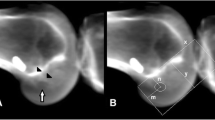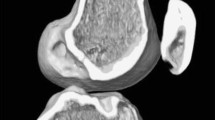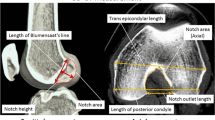Abstract
Purpose
The aims of this study were (1) to evaluate the femoral tunnel position after anatomic double-bundle and nonanatomic single-bundle reconstruction; (2) to evaluate the influence of rotation of the femur caused by limb malalignment on measurements of the position of the femoral ACL tunnel aperture relative to Blumensaat’s line.
Methods
3D CT scans were performed in 5 patients after anatomic double-bundle reconstruction and 5 patients after nonanatomic single-bundle reconstruction. Digitally reconstructed lateral radiographs were generated from the 3D CT scans to determine the tunnel position on the femur along and perpendicular to Blumensaat’s line. The femur was then rotated to simulate internal/external and varus/valgus rotations from 0° to 15° in 5° increments. At each rotated bone position, tunnel position relative to Blumensaat’s line was calculated and the difference from the lateral radiograph was calculated.
Results
After double-bundle reconstruction, the AM tunnel was located at 31.5 (±5.0) % along Blumensaat’s line and 29.7 (±13.6) % perpendicular to Blumensaat’s line, and the PL tunnel at 36.2 (±12.9) % along Blumensaat’s line and 34.2 (±7.6) % perpendicular to Blumensaat’s line. Valgus greater than 10° significantly affected the assessment of tunnel position (P = 0.043). After nonanatomic single-bundle reconstruction, the tunnel position was 35.4 (±15.0) % along Blumensaat’s line and −2.7 (±19.4) % perpendicular to Blumensaat’s line. Internal rotation of more than 10° significantly affected the assessment of tunnel position (P = 0.043).
Conclusions
Tunnel position after anatomic double-bundle reconstruction and nonanatomic single-bundle reconstruction can be determined on lateral radiographs. However, valgus and internal rotation of more than 10° can introduce significant errors in tunnel position estimates.
Level of evidence
Case series, Level IV.





Similar content being viewed by others
References
Amis AA, Beynnon B, Blankevoort L, Chambat P, Christel P, Durselen L, Friederich N, Grood E, Hertel P, Jakob R et al (1994) Proceedings of the ESSKA scientific workshop on reconstruction of the anterior and posterior cruciate ligaments. Knee Surg Sports Traumatol Arthrosc 2:124–132
Anderst W, Zauel R, Bishop J, Demps E, Tashman S (2009) Validation of three-dimensional model-based tibio-femoral tracking during running. Med Eng Phys 31:10–16
Bedi A, Maak T, Musahl V, O’Loughlin P, Choi D, Citak M, Pearle AD (2011) Effect of tunnel position and graft size in single-bundle anterior cruciate ligament reconstruction: an evaluation of time-zero knee stability arthroscopy. doi:10.1016/j.arthro.2011.03.079
Behrend H, Stutz G, Kessler MA, Rukavina A, Giesinger K, Kuster MS (2006) Tunnel placement in anterior cruciate ligament (ACL) reconstruction: quality control in a teaching hospital. Knee Surg Sports Traumatol Arthrosc 14:1159–1165
Bernard M, Hertel P (1996) Intraoperative and postoperative insertion control of anterior cruciate ligament-plasty. A radiologic measuring method (quadrant method). Unfallchirurg 99:332–340
Bernard M, Hertel P, Hornung H, Cierpinski T (1997) Femoral insertion of the ACL. Radiographic quadrant method. Am J Knee Surg 10:14–21 (discussion 21-12)
Bird JH, Carmont MR, Dhillon M, Smith N, Brown C, Thompson P, Spalding T (2011) Validation of a new technique to determine midbundle femoral tunnel position in anterior cruciate ligament reconstruction using 3-dimensional computed tomography analysis. Arthroscopy 27:1259–1267
Cohen SB, Fu FH (2007) Three-portal technique for anterior cruciate ligament reconstruction: use of a central medial portal. Arthroscopy 23:e321–e325
Colombet P, Robinson J, Christel P, Franceschi JP, Djian P, Bellier G, Sbihi A (2006) Morphology of anterior cruciate ligament attachments for anatomic reconstruction: a cadaveric dissection and radiographic study. Arthroscopy 22:984–992
Edwards A, Bull AM, Amis AA (2008) The attachments of the anteromedial and posterolateral fibre bundles of the anterior cruciate ligament: part 2: femoral attachment. Knee Surg Sports Traumatol Arthrosc 16:29–36
Ferretti M, Ekdahl M, Shen W, Fu FH (2007) Osseous landmarks of the femoral attachment of the anterior cruciate ligament: an anatomic study. Arthroscopy 23:1218–1225
Forsythe B, Kopf S, Wong AK, Martins CA, Anderst W, Tashman S, Fu FH (2010) The location of femoral and tibial tunnels in anatomic double-bundle anterior cruciate ligament reconstruction analyzed by three-dimensional computed tomography models. J Bone Joint Surg Am 92:1418–1426
George MS, Dunn WR, Spindler KP (2006) Current concepts review: revision anterior cruciate ligament reconstruction. Am J Sports Med 34:2026–2037
Kopf S, Forsythe B, Wong AK, Tashman S, Anderst W, Irrgang JJ, Fu FH (2010) Nonanatomic tunnel position in traditional transtibial single-bundle anterior cruciate ligament reconstruction evaluated by three-dimensional computed tomography. J Bone Joint Surg Am 92:1427–1431
Kopf S, Pombo MW, Szczodry M, Irrgang JJ, Fu FH (2010) Size variability of the human anterior cruciate ligament insertion sites. Am J Sports Med 39:108–113
Loh JC, Fukuda Y, Tsuda E, Steadman RJ, Fu FH, Woo SL (2003) Knee stability, graft function following anterior cruciate ligament reconstruction: comparison between 11 o’clock, 10 o’clock femoral tunnel placement. Richard O’Connor Award paper. Arthroscopy 19:297–304
Markolf KL, Hame S, Hunter DM, Oakes DA, Zoric B, Gause P, Finerman GA (2002) Effects of femoral tunnel placement on knee laxity and forces in an anterior cruciate ligament graft. J Orthop Res 20:1016–1024
Musahl V, Plakseychuk A, VanScyoc A, Sasaki T, Debski RE, McMahon PJ, Fu FH (2005) Varying femoral tunnels between the anatomical footprint and isometric positions: effect on kinematics of the anterior cruciate ligament-reconstructed knee. Am J Sports Med 33:712–718
Sakane M, Fox RJ, Woo SL, Livesay GA, Li G, Fu FH (1997) In situ forces in the anterior cruciate ligament and its bundles in response to anterior tibial loads. J Orthop Res 15:285–293
Simmons R, Howell SM, Hull ML (2003) Effect of the angle of the femoral and tibial tunnels in the coronal plane and incremental excision of the posterior cruciate ligament on tension of an anterior cruciate ligament graft: an in vitro study. J Bone Joint Surg Am 85-A:1018–1029
Topliss C, Webb J (2001) An audit of tunnel position in anterior cruciate ligament reconstruction. Knee 8:59–63
van Eck CF, Martins CA, Vyas SM, Celentano U, van Dijk CN, Fu FH (2010) Femoral intercondylar notch shape and dimensions in ACL-injured patients. Knee Surg Sports Traumatol Arthrosc 18:1257–1262
van Eck CF, Morse KR, Lesniak BP, Kropf EJ, Tranovich MJ, van Dijk CN, Fu FH (2011) Does the lateral intercondylar ridge disappear in ACL deficient patients? Knee Surg Sports Traumatol Arthrosc 18:1184–1188
Zantop T, Wellmann M, Fu FH, Petersen W (2008) Tunnel positioning of anteromedial and posterolateral bundles in anatomic anterior cruciate ligament reconstruction: anatomic and radiographic findings. Am J Sports Med 36:65–72
Zelle BA, Brucker PU, Feng MT, Fu FH (2006) Anatomical double-bundle anterior cruciate ligament reconstruction. Sports Med 36:99–108
Acknowledgments
The Authors wish to thank Mike Tranovich and Zachri Buzzinotti for the help with the statistical analysis of the data and helpful discussion. The authors did not receive any outside funding or grants directly related to the research presented in this manuscript. The research that forms the basis for this manuscript was done at our institution. Our institution receives a research grant from Smith and Nephew to support research related to ACL reconstruction.
Author information
Authors and Affiliations
Corresponding author
Additional information
This study was approved by our institutional research board.
Rights and permissions
About this article
Cite this article
van Eck, C.F., Wong, A.K., Irrgang, J.J. et al. The effects of limb alignment on anterior cruciate ligament graft tunnel positions estimated from plain radiographs. Knee Surg Sports Traumatol Arthrosc 20, 979–985 (2012). https://doi.org/10.1007/s00167-011-1683-x
Received:
Accepted:
Published:
Issue Date:
DOI: https://doi.org/10.1007/s00167-011-1683-x




